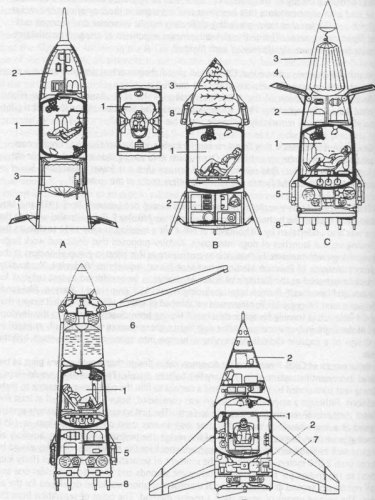- Joined
- 27 December 2005
- Messages
- 16,881
- Reaction score
- 21,549
Between April 1955 and May 1956, following previous development efforts dating back to Tikhonrarov's work at NII-1 in 1945-49, Korolev's OKB-1 and Tikhonrarov (now at NII-4) studied various scheme for a manned vehicle meant for vertical launches up to an altitude of 200km by the final Soviet development of the German A-4 ("V2"), the R-2A. They varied mainly in the way they were decelerated for a safe landing.
Vehicle A had a large parachute, airbrakes and a nose spike. Vehicle B had a large parachute and small solid retro-rockets. Vehicle C had a smaller parachute for initial deceleration and solid retro-rockets and airbrakes for the landing phase. Vehicle D had a folded rotor, that would unfold and be spun into rotation by the blade-tip nozzles of a cold liquid-propellant rocket engine. Vehicle E had wings and was stabilized by attitude control nozzles fed from a similar rocket; it was the only one able to fly downrange (up to 1000km). Korolev preferred D and E, but then (1957) decided to jump the vertical flight and sub-orbital ballistic flight steps altogether and to attempt directly orbital flight at 250-300km altitude (objekt K started in February 1958, leading to OD-2 to be Vostok and to the first Soviet reconnaissance satellite, Zenith-2 11F61). Work on vertical flight vehicles ended in November 1958 and orbital flight was sanctioned by joint decree 22-10 of the Central Committee of the CP(b)SU and of the Soviet of Ministers of the USSR on January 5, 1959.
(from Sowjetischer Raketen, P. Satche, Militärverlag der DDR, Ost-Berlin, 1987, reproduced in other books since, eg Sputnik and the Soviet Space Challenge, Asif A. Siddiqi, University Press of Florida).
Vehicle A had a large parachute, airbrakes and a nose spike. Vehicle B had a large parachute and small solid retro-rockets. Vehicle C had a smaller parachute for initial deceleration and solid retro-rockets and airbrakes for the landing phase. Vehicle D had a folded rotor, that would unfold and be spun into rotation by the blade-tip nozzles of a cold liquid-propellant rocket engine. Vehicle E had wings and was stabilized by attitude control nozzles fed from a similar rocket; it was the only one able to fly downrange (up to 1000km). Korolev preferred D and E, but then (1957) decided to jump the vertical flight and sub-orbital ballistic flight steps altogether and to attempt directly orbital flight at 250-300km altitude (objekt K started in February 1958, leading to OD-2 to be Vostok and to the first Soviet reconnaissance satellite, Zenith-2 11F61). Work on vertical flight vehicles ended in November 1958 and orbital flight was sanctioned by joint decree 22-10 of the Central Committee of the CP(b)SU and of the Soviet of Ministers of the USSR on January 5, 1959.
(from Sowjetischer Raketen, P. Satche, Militärverlag der DDR, Ost-Berlin, 1987, reproduced in other books since, eg Sputnik and the Soviet Space Challenge, Asif A. Siddiqi, University Press of Florida).

